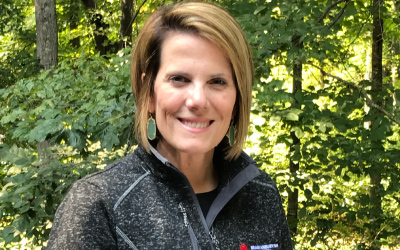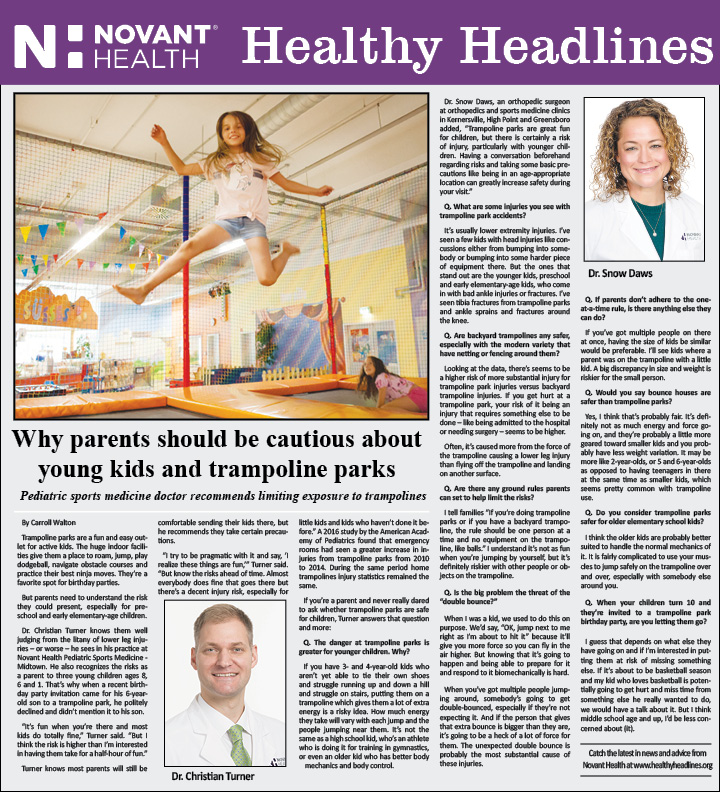 Corie Maffett, a teacher at East Forsyth Middle School, is thankful to be alive and tell her story to help others as the NC representative for the Brain Aneurysm Foundation (BAF).
Corie Maffett, a teacher at East Forsyth Middle School, is thankful to be alive and tell her story to help others as the NC representative for the Brain Aneurysm Foundation (BAF).
According to the BAF, a brain aneurysm is a weak bulging spot on the wall of a brain artery. Over time, the blood flow within the artery pounds against the thinned portion of the wall and aneurysms form silently from wear and tear on the arteries. As the artery wall becomes gradually thinner from the dilation, the blood flow causes the weakened wall to swell outward. This pressure may cause the aneurysm to rupture and allow blood to escape into the space around the brain. A ruptured brain aneurysm commonly requires advanced surgical treatment.
It is estimated that six million people in the US have an unruptured brain aneurysm, or 1 in 50 people.
Maffett explained that she had a brain aneurysm six years ago in October 2011. She was working out at the gym when she felt a radiating pain up the back of her neck that stopped her cold.
“The pain was like nothing I’d ever experienced,” she said.
Doing what she encourages others not to do, Maffett drove home. She explained that when her husband, Guy, arrived at the house he immediately knew something wasn’t right.
“Guy came home. My car was in the driveway and the car door was still open,” she said. “There were wet footprints on the floor from where I’d taken a shower and I was laying on the couch.”
Maffett said her husband asked her if she was okay, and she told him she just wanted to take some Tylenol and go to bed, but luckily, he wouldn’t allow her to do so.
“Guy said, ‘No, let’s go to the hospital,’” she said, noting that she went to Novant Health Kernersville Medical Center. “I got there and they handed me a tray in case I got sick.”
While in the waiting room, Maffett said she was in so much pain she got up and went back to the ER.
“I told them I was having the worst headache of my life. I guess that is a code phrase because a doctor said to get me a scan right away and then ended up transferring me to Forsyth Medical Center,” she said, noting that she spent 11 days in the Neurosurgical Intensive Care Unit. “I had an aneurysm that ruptured, and when they found that one, they found three more.”
Maffett said if she had gone to bed that night instead of going to the hospital, she probably wouldn’t have woken up.
Maffett went back in January 2012 and underwent endovascular coiling of the larger aneurysm.
“I still have two of them, but they are pretty small and are being watched,” she said. “I go every five years to have them checked.”
After getting out of the hospital, Maffett said she joined the BAF and their Facebook page, both for support and as a resource to gain more information.
Maffett said the foundation reached out to her this summer to see if she wanted to be the representative for the state of NC and to tell her story.
“I wanted to tell my story, because if I can save one person, it’s worthwhile,” she said. “If one person reads my story, and has a headache like I did, it might get them to the hospital.”
Maffett said she is thankful that she doesn’t have any lasting symptoms from the ruptured aneurysm.
“If that first aneurysm hadn’t ruptured, the larger one would never have been detected, and I probably wouldn’t have survived if it had ruptured,” she said. “And, if my husband hadn’t insisted on taking me to the hospital, I’m sure I wouldn’t have lived through that night, as the bleed was substantial.”
Through her experience, Maffett also gained a lasting friendship with one of her ICU nurses, Danielle. Maffett’s daughter was also inspired to become a nurse.
In telling her story as a representative for the BAF, Maffett urges everyone to become aware of the warning signs of a brain aneurysm and to not brush off any unusual symptoms like she had attempted to do.
“Listen to your body and get help if something seems wrong,” she said. “It could save your life.”
For more information about brain aneurysms and the BAF, visit www.bafound.org.
Brain Aneurysm Foundation
Previous post: 200 Club of the Triad
Next post: Hiatt









